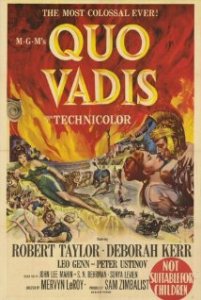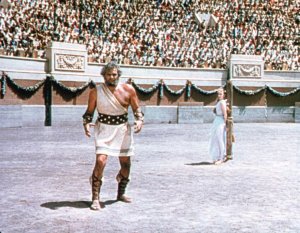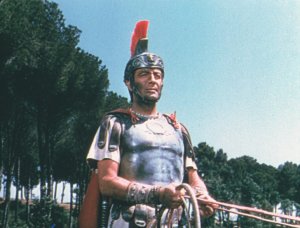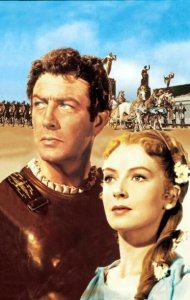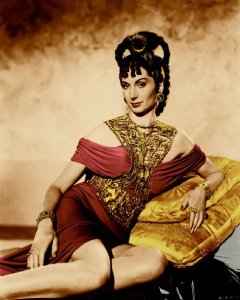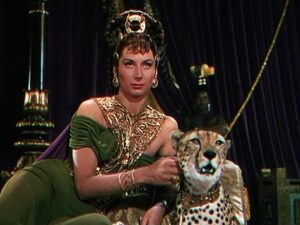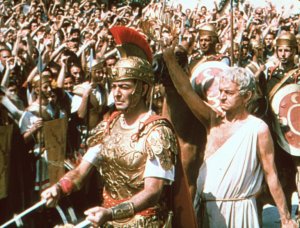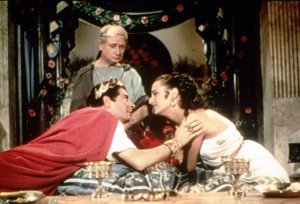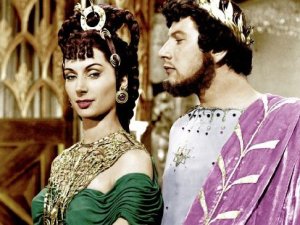Quo Vadis? **** (1951, Robert Taylor, Deborah Kerr, Leo Genn, Peter Ustinov, Patricia Laffan, Finlay Currie, Abraham Sofaer) – Classic Movie Review 2253
MGM’s plush and lavish 1951 Technicolor biblical epic blockbuster film Quo Vadis? stars Robert Taylor and Deborah Kerr, as the crazed Emperor Nero (Peter Ustinov) fiddles while Rome burns, chariots race, armies march and lions eat Christians.
Director Mervyn Leroy’s plush and lavish 1951 Technicolor biblical epic blockbuster film Quo Vadis? stars Robert Taylor as General Marcus Vinicius, the Roman legion commander who risks his life by falling for the lovely Christian woman Lygia (Deborah Kerr), as the crazed Emperor Nero (Peter Ustinov) fiddles while Rome burns, chariots race, armies march and lions eat Christians.
A gleeful throwback to the good old days of cinema, the 1951 Quo Vadis? is a remake of a once famous 1924 silent movie with Emil Jannings, and is the fourth screen adaptation of Henryk Sienkiewicz’s source novel. Produced by Sam Zimbalist, it was nominated for eight Oscars but, in a surprise upset at the Academy Awards, it didn’t win any. However, Peter Ustinov won the Golden Globe Award for Best Supporting Actor – Motion Picture, and Robert Surtees and William V Skall won the award for Best Cinematography.
It was filmed by MGM with literally a cast of thousands (there are 5,500 people in the march to Nero’s palace alone) at the then still fairly new Cinecittà studios in Rome in the most splashy, spectacular Cecil B DeMille retro epic style. MGM obtained a lease on the huge Cinecittà Studios, eight miles outside Rome, with its 148 acres and nine soundstages.
The Cinecittà studios were founded in 1937 by Benito Mussolini, his son Vittorio, and his head of cinema Luigi Freddi under the slogan ‘Il cinema è l’arma più forte’ (‘Cinema is the most powerful weapon’). They offered what Hollywood needed: immense facilities and cheap Ita?ian labour and extras. It was nicknamed ‘Hollywood on the Tiber’ in 1950 while Quo Vadis? was being shot in Rome.
There was a slight drawback though. Rome was in the grip of an extreme heatwave in the summer of 1950. Peter Ustinov recalled: ‘Rome was in the throes of Holy Year, and bursting with pilgrims. It was also one of the hottest summers on record.’ That was bad for the cast and crew, but also for the lions, who were reluctant to enter the arena because of the heat!
The immense, costly production, Cedric Gibbons, Edward C Carfagno and William A Horning’s exciting set designs, Miklos Rozsa’s thrilling music score, Robert Surtees and William V Skall’s eye-catching Technicolor cinematography are highly impressive. And several of the performances – especially by Ustinov, Leo Genn as Nero’s silky confidant Petronius, Patricia Laffan as the Empress Poppaea, Nora Swinburne as Pomponia, the 20 lions and two cheetahs – are first rate.
It was the most expensive film ever made at the time, costing $7.6 million, but it became MGM’s highest grossing film since Gone with the Wind (1939). It spawned a series of similar epis, and eventually two other Hollywood spectacles –Ben-Hur (1959), and Cleopatra (1963) –went on to dwarf Quo Vadis? in scale when they were made at Cinecitta.
However, there are some downsides too. Bland performances from the principals Taylor and Kerr and the periodic lapses into tedium created by a lack of dynamism through the film’s massive length at 171 minutes are the main demerits.
It was released by MGM on 2 November 1951 A big box office hit, it cost $7.6 million and brought in more than $25 million. There must have been great relief at the studio, as it was credited with single-handedly rescuing MGM from the brink of bankruptcy.
John Lee Mahin, S N Behrman and Sonya Levien’s screenplay is based on the 1896 novel of the same title by Polish Nobel Laureate author Henryk Sienkiewicz.
Walter Pidegon, uncredited, narrates the movie. Anthony Mann is an uncredited director.
Sophia Loren appears uncredited as Lygia’s slave and Elizabeth Taylor makes a cameo appearance as a Christian prisoner in the arena. Also appearing are Christopher Lee as a chariot driver, Clelia Matania as Parmenida the hairdresser, Marika Aba as the Assyrian Dancer at Nero’s banquet, Richard Garrick as a slave with Marcus at Triumph, Giuseppe Tosi as a wrestler at Nero’s banquet, Adrienne Corri as an imprisoned Christian woman, Bud Spencer as an Imperial Guard, and Robin Hughes as Jesus in a flashback tableaux.
Also in the cast are Finlay Currie as Peter, Abraham Sofaer as Paul, as well as Marina Berti (as Eunice), Buddy Baer, Felix Aylmer, Ralph Truman, Norman Wooland, Peter Miles, Geoffrey Dunn, Nicholas Hannen, D A Clarke-Smith, Rosalie Crutchley, John Ruddock, Arthur Walge, Elspeth March, Strelsa Brown, Alfredo Varelli, Roberto Ottaviano, William Tubbs and Pietro Tordi.
The cross may not have been used as a Christian symbol until the second century AD, some decades after the setting of Quo Vadis?.
The 2009 two disc DVD release from Warner Home Video shows the movie in perfect pristine colour resolution.
Remade as a TV movie in 1985 with Klaus-Maria Brandauer and Max Von Sydow.
Patricia Laffan was born on March 19 1919 in Wandsworth, London, and is also known for Devil Girl from Mars (1954) and 23 Paces to Baker Street (1956).
Producer Zimbalist and director Leroy chose her as Nero’s second wife Poppaea on seeing her screen test for a smaller part in the film. She steals the show with costumes by Herschel McCoy, hairstyles by Sydney Guilaroff, jewellery by Joseff of Hollywood, and two pet cheetahs on golden leashes.
© Derek Winnert 2015 Classic Movie Review 2253
Check out more reviews on http://derekwinnert.com/

